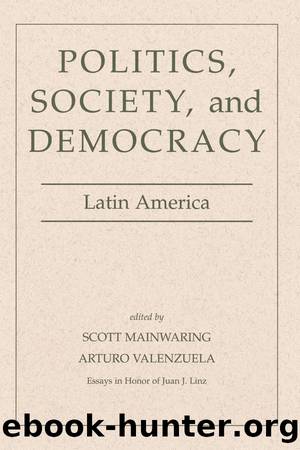Politics, Society, and Democracy Latin America by Scott Mainwaring

Author:Scott Mainwaring [Mainwaring, Scott]
Language: eng
Format: epub
Tags: Political Science, General
ISBN: 9780429977770
Google: FtJMDwAAQBAJ
Publisher: Routledge
Published: 2018-02-19T12:39:52+00:00
Modest Proposals for Reform
Since political engineering is unlikely to bring fundamental changes in party systems, it follows that Latin American reformers should consider changes designed to make political institutions more âcongruentâ with political behavior. If presidentialism is retained, there are several reforms that might lessen its fragility. Scheduling congressional elections only in presidential election years would minimize the erosion of support that many presidents experience in off-year elections, though it would also deprive a minority president of the chance to campaign for greater congressional support. Requiring the electorate to vote for straight party lists for the presidency and the legislature would help to provide presidents with congressional allies in numbers roughly proportionate to the presidentâs share of the vote and would also help presidents in two party systems to achieve congressional majorities. The adoption of such a measure, however, would not solve the problem of minority presidencies in multiparty contexts. Presidents could also be given the power to dissolve congress at least once during their tenure in office. Dissolution, however, does not guarantee that a president will obtain a majority in the new elections, so it leaves open the possibility that even more serious deadlock will occur.
Because runoff elections do nothing to provide minority presidents with majority support in the parliament, reformers might consider having congress select the president from the top two or three vote-getters in the first round. As the case of Bolivia illustrâtes, a president elected by congress is a president who knows the value and importance of compromise with political adversaries and who is keenly aware of the need to maintain viable congressional coalitions. Despite its poor longterm record of constitutional democracy, Bolivia has recently become one of Latin Americaâs democratic success stories, in part because the election of the president by congress has encouraged the creation of working majority coalitions. It was the coalition government of the center-right Nationalist Revolutionary Movement (MNR) and the rightist National Democratic Action (ADN) that implemented in 1985 the successful macroeconomic stabilization program that broke the hyperinflationary spiral in Bolivia. And it was the coalition government of the ADN and the center-left Movement of the Revolutionary Left (MIR), generated by congressional agreement in 1989, which permitted the Paz Zamora government to maintain political stability while making some progress on economic and social problems. The success of the government of Gonzalo Sanchez de Lozada (1993â1997) in enacting, after a fitful start, widespread reforms for popular participation and capitalization:, are a tribute to the continued vitality of congressionally generated majority coalitions. The contrast between Bolivia and Peru, countries that share many of the same daunting problems, could not be starker. Democratic politics of compromise and conciliation have enabled Bolivia to make difficult decisions without resorting to authoritarian tactics while at the same time consolidating democratic institutions.
The problem with congressional election of minority presidents is that the winning coalition, while likely to be more stable than one formed in the heat of a popular runoff, is still not guaranteed to last for the duration of an entire presidential term.
Download
This site does not store any files on its server. We only index and link to content provided by other sites. Please contact the content providers to delete copyright contents if any and email us, we'll remove relevant links or contents immediately.
Harry Potter and the Goblet Of Fire by J.K. Rowling(3041)
Never by Ken Follett(2880)
Shadow of Night by Deborah Harkness(2718)
Ogilvy on Advertising by David Ogilvy(2682)
Zero to IPO: Over $1 Trillion of Actionable Advice from the World's Most Successful Entrepreneurs by Frederic Kerrest(2392)
The Man Who Died Twice by Richard Osman(2297)
Machine Learning at Scale with H2O by Gregory Keys | David Whiting(2289)
Book of Life by Deborah Harkness(2263)
How Proust Can Change Your Life by Alain De Botton(2261)
My Brilliant Friend by Elena Ferrante(2223)
0041152001443424520 .pdf by Unknown(2220)
The Tipping Point by Malcolm Gladwell(2204)
How to Pay Zero Taxes, 2018 by Jeff A. Schnepper(2098)
Will by Will Smith(2041)
Purple Hibiscus by Chimamanda Ngozi Adichie(1981)
Hooked: A Dark, Contemporary Romance (Never After Series) by Emily McIntire(1958)
Borders by unknow(1785)
Rationality by Steven Pinker(1764)
Daughter of Smoke and Bone by Laini Taylor(1742)
